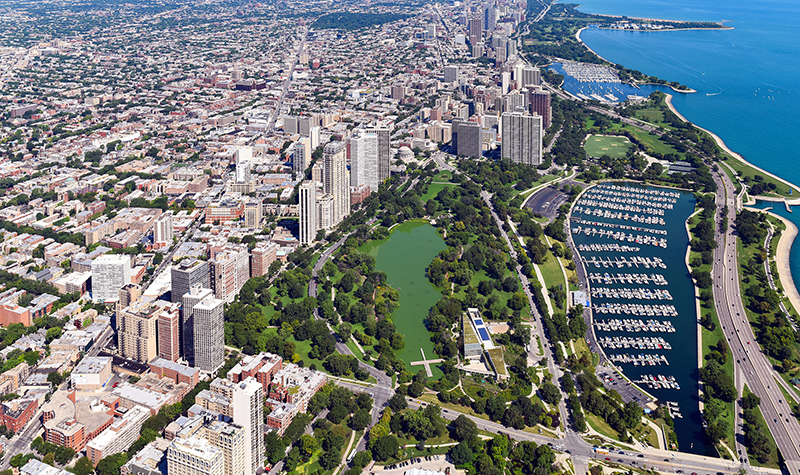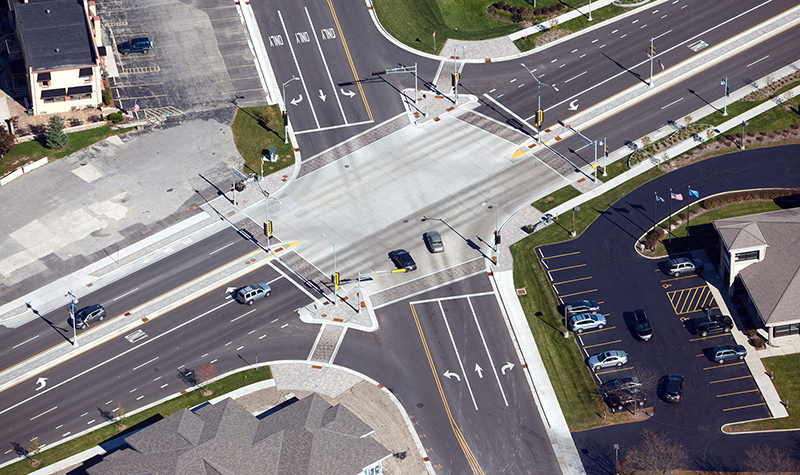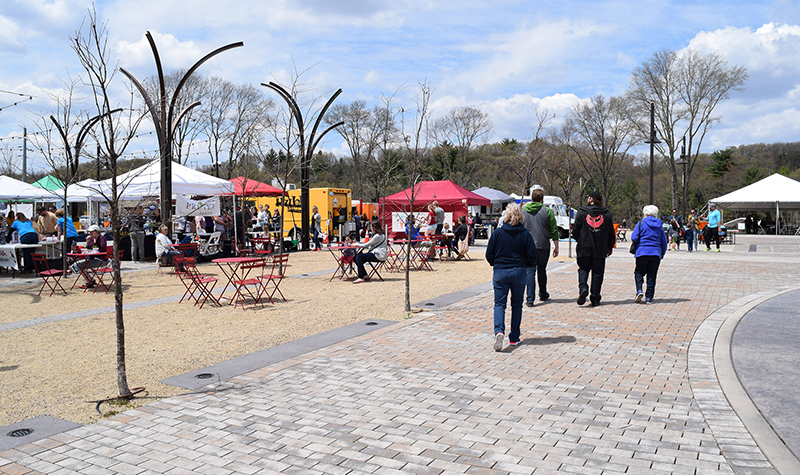How to Minimize the Impact of Urban Heat Islands

Many city dwellers flee to the countryside to cool off when summer’s heat hits – and for good reason. Urban areas tend to be hotter than the surrounding countryside because of the “urban heat island” effect. Urban heat islands occur in urbanized areas where vegetation and trees have been greatly reduced or eliminated and there are increased concentrations of impermeable surfaces such as roads, dark colored pavement, and buildings that absorb, retain, and re-emit heat. According to the U.S. Environmental Protection Agency, cities of a million or more residents can be as much as 5 to 7 degrees warmer in the day and 22 degrees warmer in the evening.
Heat islands can form under a variety of conditions, including during the day or night, in small or large cities, in suburban areas, in northern or southern climates, and in any season. Temperatures can also vary within the city.
How Do Urban Heat Islands Affect Us?
Those higher temperatures come at a cost to human comfort and health, economics, and the environment. Higher temperatures can contribute to heat-related deaths and illnesses such as respiratory concerns, heat cramps, heat exhaustion, and non-fatal heatstroke.
Higher temperatures also mean higher energy demand to operate the fans and air conditioners that keep humans and machinery cooler. Peak demand on hot summer weekday afternoons can overload systems, causing blackouts or rolling brownouts that are scheduled to avoid power outages and the accompanying danger to public health and welfare.
Higher demand for electricity translates into the need for more energy output from electrical generation facilities, which often rely on fossil fuels. The result is an increase in air pollution and greenhouse gas emissions.
Cities also have systems for channeling stormwater into storm sewers and from there often to streams, rivers, ponds, and lakes. In urban heat islands, streets, sidewalks, gutters, rooftops, and other impermeable surfaces are hotter than the ground surrounding a forest stream, for example. The result is warmer stormwater entering area surface waters, which could affect aquatic life.
Is Your City Suffering from Low Albedo?
The difference in temperature between urban and less-developed rural areas has to do with how well the surfaces in each environment absorb and hold heat. This is called the Albedo effect. Albedo is an expression of the ability of surfaces to reflect the heat from the sun. Light colored surfaces return a large part of the rays back to the atmosphere (high albedo number), and dark surfaces absorb the rays from the sun (low albedo).

Therefore, all that makes a city a city contributes to the formation of urban heat islands:
- Structures such as buildings and roads absorb and release the sun’s heat more than natural landscapes such as meadows and forests. During the day, structures can store more heat than plants. At night, structures emit some of that heat, contributing to warmer temperatures even when it’s dark. Trees and other vegetation tend to cool the air by providing shade and through transpiring moisture from plant leaves. Water evaporating from the surface of ponds or lakes also has a cooling effect. Urban areas usually have less vegetation and fewer water features than rural areas.
- Land surfaces in a city often are less reflective, allowing them to soak up more heat from the sun. Dark objects absorb light energy and convert it into heat; those objects get warm. White or light colored objects reflect light, which therefore is not converted into heat. Dark asphalt, for example, will absorb more light than a lighter colored walkway. Under the same conditions the asphalt will feel warmer than the lighter walkway.
- In areas of a city with narrow streets and tall buildings, the buildings may provide shade, but they also block natural wind flow that might provide cooling. In heavily developed areas, buildings obstructed by neighboring buildings become thermal masses that do not release heat efficiently.
- Weather and geography also affect the intensity of urban heat islands. Calm, clear weather maximizes the amount of solar energy reaching urban surfaces and minimizes the cooling effect of wind. Strong winds and frequent cloud cover help reduce urban heat island formation.
What Can We Do to Mitigate the Effect of Urban Heat Islands?
Some of the factors that help cause urban heat islands are impossible to change, such as geography or weather. Other factors are not practical to change. No one would suggest tearing down all tall buildings to increase wind flow, for example.

Modifications to existing structures and changes in urban planning, however, could reduce the impact of urban heat islands:
- Increase the reflectiveness of the city to reduce the amount of heat absorbed during the day. This can be accomplished by refurbishing existing roofs and building new roofs with white or another light reflective color. Cover black asphalt streets and parking lots with a lighter, more reflective coating. Use lighter colored materials in the construction of new infrastructure and pavements.
- Cities and counties can retain more right-of-way area to increase space for trees and vegetation to provide shade and cooling effects through evapotranspiration. Some of the moisture that plants store in stems and leaves becomes water vapor and is released in the air, a process called transpiration – nature’s air conditioner. Some research indicates that in dry areas, plants would have to be watered for the best effect. Not all plants would have to be at ground level; growing a vegetative layer on an existing or newly constructed rooftop (a vegetated roof) reduces the temperature of the roof surface and surrounding area. A vegetated roof also reduces energy use and costs. The City of Tucson, Arizona, started the Trees for Tucson ReLeaf urban forestry program in 1989, which today is called the Tucson Million Trees Initiative with the goal of planting a million trees by 2030 to help mitigate the effects of heat islands and climate change. Measurements from the EPA have shown a decrease in temperature.
- Use permeable, light colored paving materials. Traditional materials create impervious surfaces – areas where water can’t flow through. Without a cycle of flowing and evaporating water, the surfaces do not cool efficiently. Permeable surfaces and pavers allow water to flow through, which has a cooling effect.
- Incorporate green infrastructure to cool stormwater runoff and improve water quality. Measures would include rain gardens, bioswales, Silva Cell® tree planters, and planter areas in pavements, as well as the use of permeable building materials whenever possible.
- Design new developments to include smart growth practices, use ecosystem services and make urban areas more attractive, economically stronger, and more livable. Examples include requiring buildings of different heights to allow more air circulation, incorporating green space, increasing the required number of trees, and mandating lighter colors for new buildings and pavements.
What’s the Forecast? Potentially Cooler
Refurbishing or installing a light colored roof, planting a vegetated roof garden, making pavements a lighter color, or removing some pavement to plant a tree may seem like small measures – too small to have any effect on something as large as the climate of a city. But research indicates such measures employed city-wide could reduce the impact of urban heat islands and benefit city residents and the environment. New developments designed with smart growth practices in mind could result in urban areas that are by their nature cooler and more comfortable than older portions of the city. The forecast carries hope.
Visit our landscape architecture page for more about the services we offer.

Comments are closed.